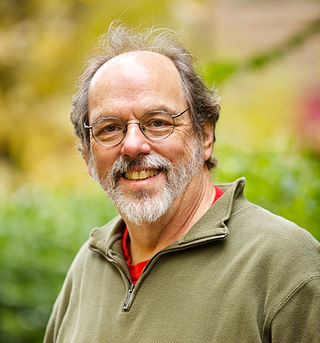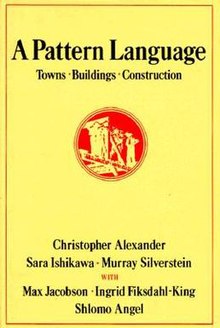
Christopher Wolfgang John Alexander was an Austrian-born British-American architect and design theorist. He was an emeritus professor at the University of California, Berkeley. His theories about the nature of human-centered design have affected fields beyond architecture, including urban design, software, and sociology. Alexander designed and personally built over 100 buildings, both as an architect and a general contractor.
A design pattern is the re-usable form of a solution to a design problem. The idea was introduced by the architect Christopher Alexander and has been adapted for various other disciplines, particularly software engineering.

Howard G. Cunningham is an American computer programmer who developed the first wiki and was a co-author of the Manifesto for Agile Software Development. A pioneer in both design patterns and extreme programming, he started coding the WikiWikiWeb in 1994, and installed it on c2.com on March 25, 1995, as an add-on to the Portland Pattern Repository. He co-authored a book about wikis, entitled The Wiki Way, and invented the Framework for Integrated Test.
In software engineering, a design pattern describes a relatively small, well-defined aspect of a computer program in terms of how to write the code.
A pattern language is an organized and coherent set of patterns, each of which describes a problem and the core of a solution that can be used in many ways within a specific field of expertise. The term was coined by architect Christopher Alexander and popularized by his 1977 book A Pattern Language.
An anti-pattern in software engineering, project management, and business processes is a common response to a recurring problem that is usually ineffective and risks being highly counterproductive. The term, coined in 1995 by computer programmer Andrew Koenig, was inspired by the book Design Patterns and first published in his article in the Journal of Object-Oriented Programming. A further paper in 1996 presented by Michael Ackroyd at the Object World West Conference also documented anti-patterns.
Pattern in architecture is the idea of capturing architectural design ideas as archetypal and reusable descriptions. The term pattern in this context is usually attributed to Christopher Alexander, an Austrian born American architect. The patterns serve as an aid to design cities and buildings. The concept of having collections of "patterns", or typical samples as such, is much older. One can think of these collections as forming a pattern language, whereas the elements of this language may be combined, governed by certain rules.
The Portland Pattern Repository (PPR) is an online repository for computer programming software design patterns. It was accompanied by the website WikiWikiWeb, the world's first wiki. The repository has an emphasis on Extreme Programming is hosted by Cunningham & Cunningham (C2) of Portland, Oregon. The PPR's motto is "People, Projects & Patterns".
The concept of design paradigms derives from the rather ambiguous idea of paradigm originating in the sociology of science, which carries at least two main meanings:

The Oregon Experiment is a 1975 book by Christopher Alexander and collaborators Murray Silverstein, Shlomo Angel, Sara Ishikawa, and Denny Abrams. It describes an experimental approach to campus community planning at the University of Oregon, in Eugene, Oregon which resulted in a theory of architecture and planning described in the group's later published and better-known volumes A Pattern Language and The Timeless Way of Building.

Notes on the Synthesis of Form is a book by Christopher Alexander about the process of design.
Interaction design patterns are design patterns applied in the context human-computer interaction, describing common designs for graphical user interfaces.
An architectural pattern is a general, reusable resolution to a commonly occurring problem in software architecture within a given context. The architectural patterns address various issues in software engineering, such as computer hardware performance limitations, high availability and minimization of a business risk. Some architectural patterns have been implemented within software frameworks.
Software analysis patterns or analysis patterns in software engineering are conceptual models, which capture an abstraction of a situation that can often be encountered in modelling. An analysis pattern can be represented as "a group of related, generic objects (meta-classes) with stereotypical attributes, behaviors, and expected interactions defined in a domain-neutral manner."

Nikos Angelos Salingaros is a mathematician and polymath known for his work on urban theory, architectural theory, complexity theory, and design philosophy. He has been a close collaborator of the architect Christopher Alexander, with whom Salingaros shares a harsh critical analysis of conventional modern architecture. Like Alexander, Salingaros has proposed an alternative theoretical approach to architecture and urbanism that is more adaptive to human needs and aspirations, and that combines rigorous scientific analysis with deep intuitive experience.
Murray Silverstein co-authored the books A Pattern Language and The Oregon Experiment. At that time, he taught architecture courses at the University of California, and subsequently taught at the University of Washington. He had also written several articles on pattern languages. As a young designer, he worked for noted California architect Richard Neutra.
PALLAS stands for Parallel Applications, Libraries, Languages, Algorithms, and Systems. It is a research group in The Parallel Computing Laboratory of the Electrical Engineering and Computer Science Department at University of California, Berkeley, led by Professor Kurt Keutzer. The group believes that the productive development of applications for an emerging generation of highly parallel microprocessors is the preeminent programming challenge of our time. Its goal is to enable the productive development of efficient parallel applications by domain experts, not just parallel programming experts.

The Timeless Way of Building is a 1979 book by Christopher Alexander that proposes a new theory of architecture that relies on the understanding and configuration of design patterns. Although it came out later, it is essentially the introduction to A Pattern Language and The Oregon Experiment, providing the philosophical background to the Center for Environmental Structure series.
Michael West Mehaffy is an urbanist, architectural theorist, urban philosopher, researcher, educator, and executive director of Sustasis Foundation, based in Portland, Oregon, USA.
A design system is a collection of reusable components and clear standards that can be assembled together to build any number of applications. Design systems aid in digital product design and development of products such as mobile applications or websites. They may contain but are not limited to, pattern/component libraries, design languages, style guides, coded components, brand languages, and documentation.







